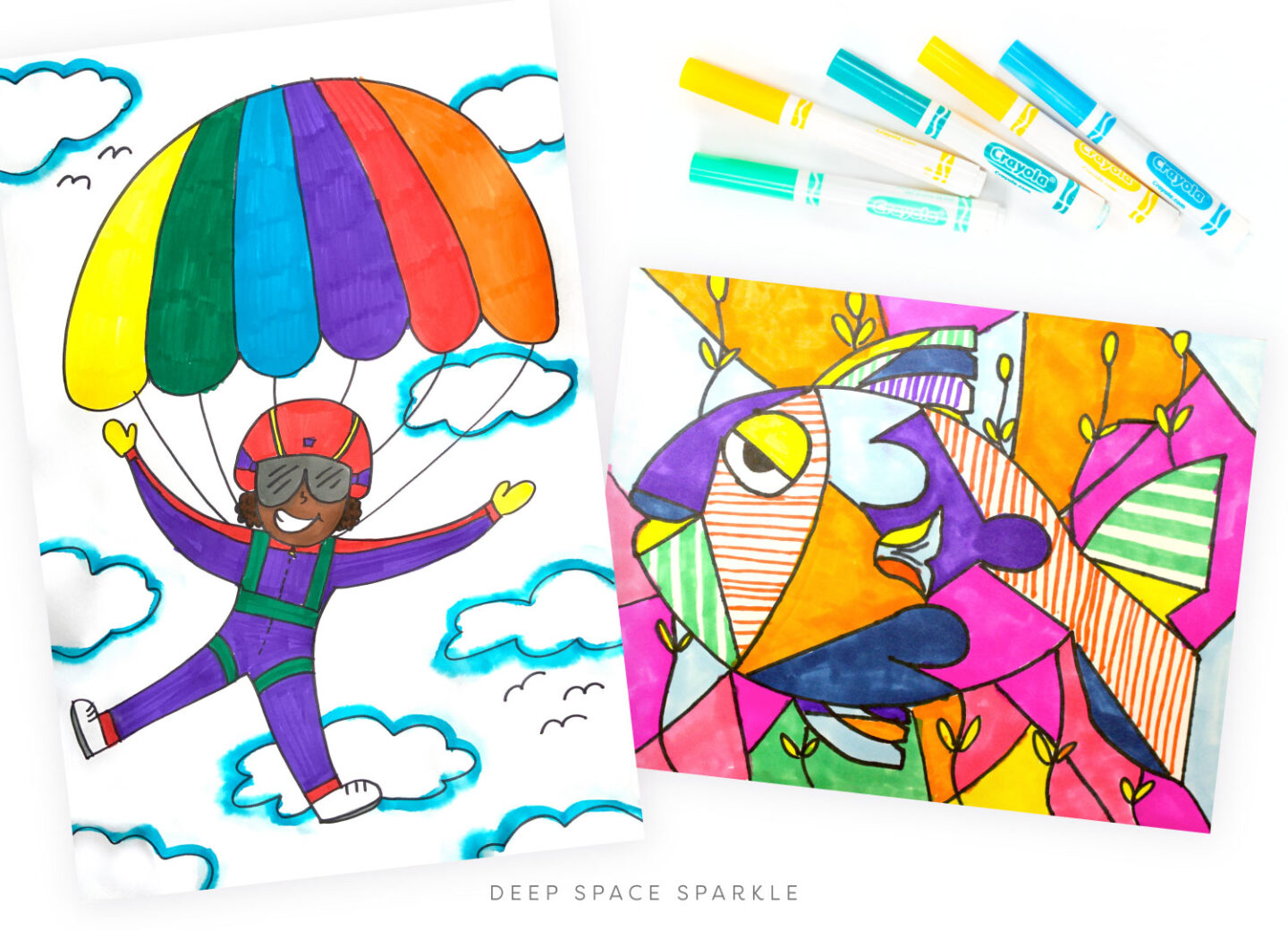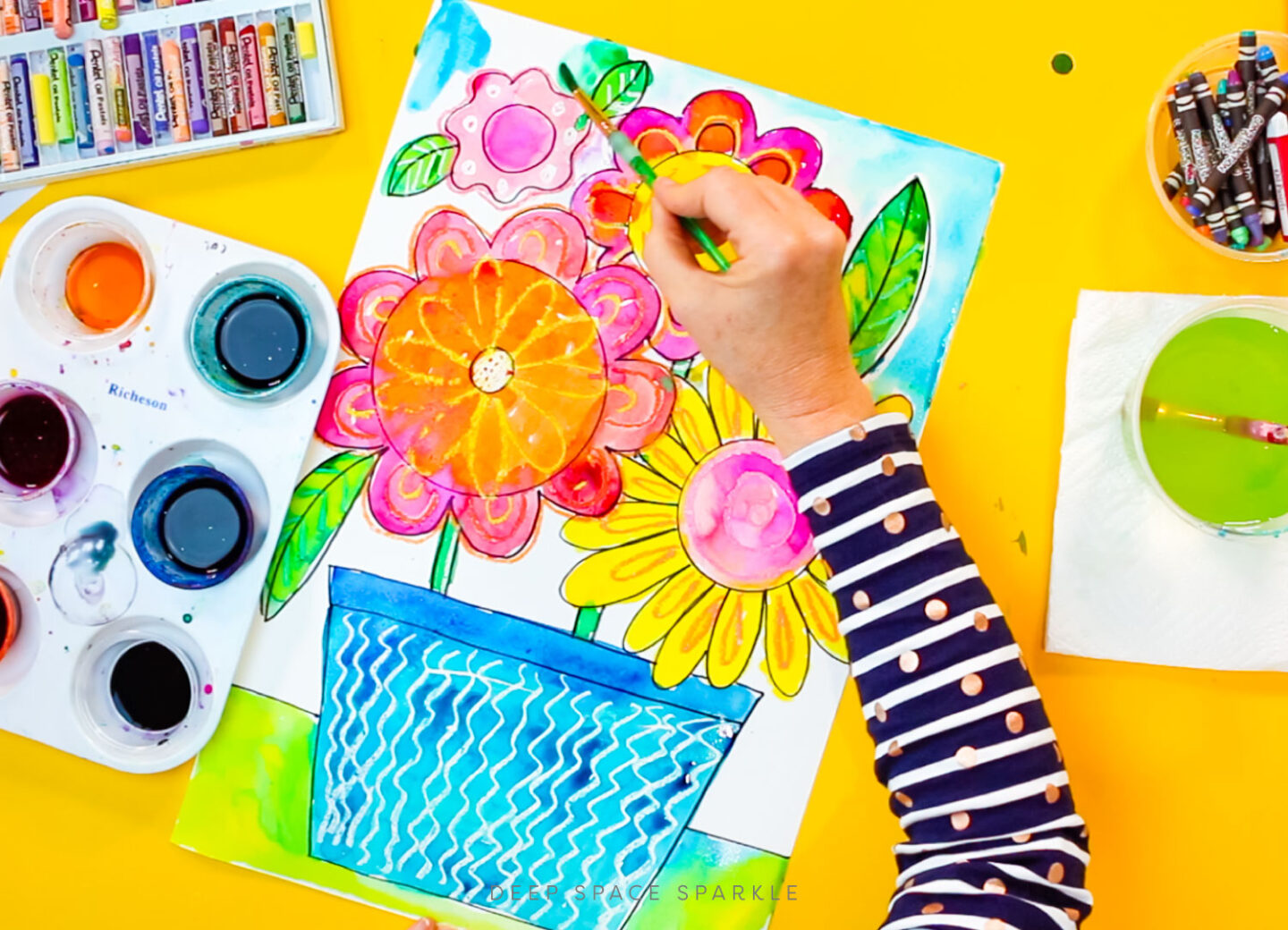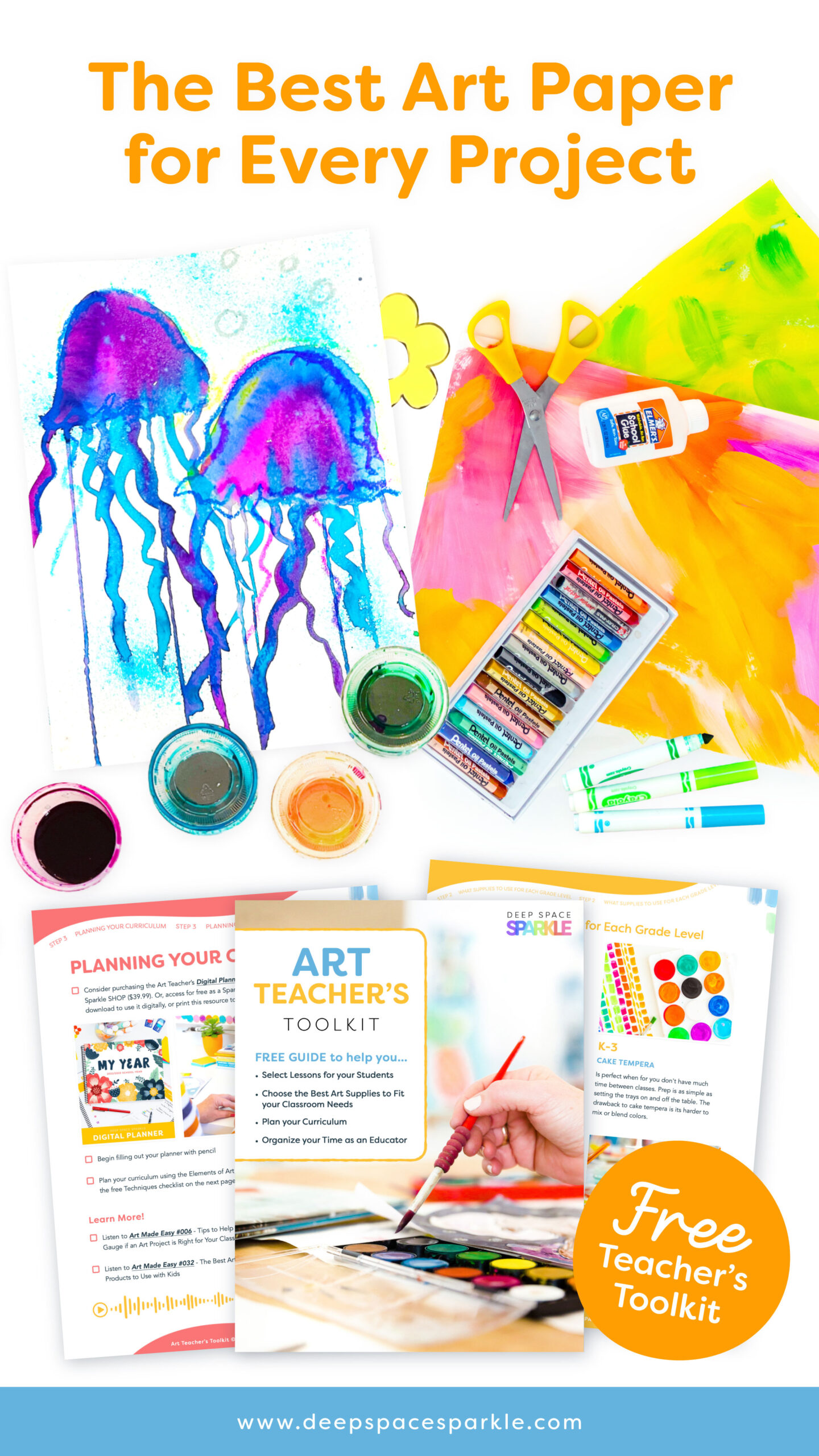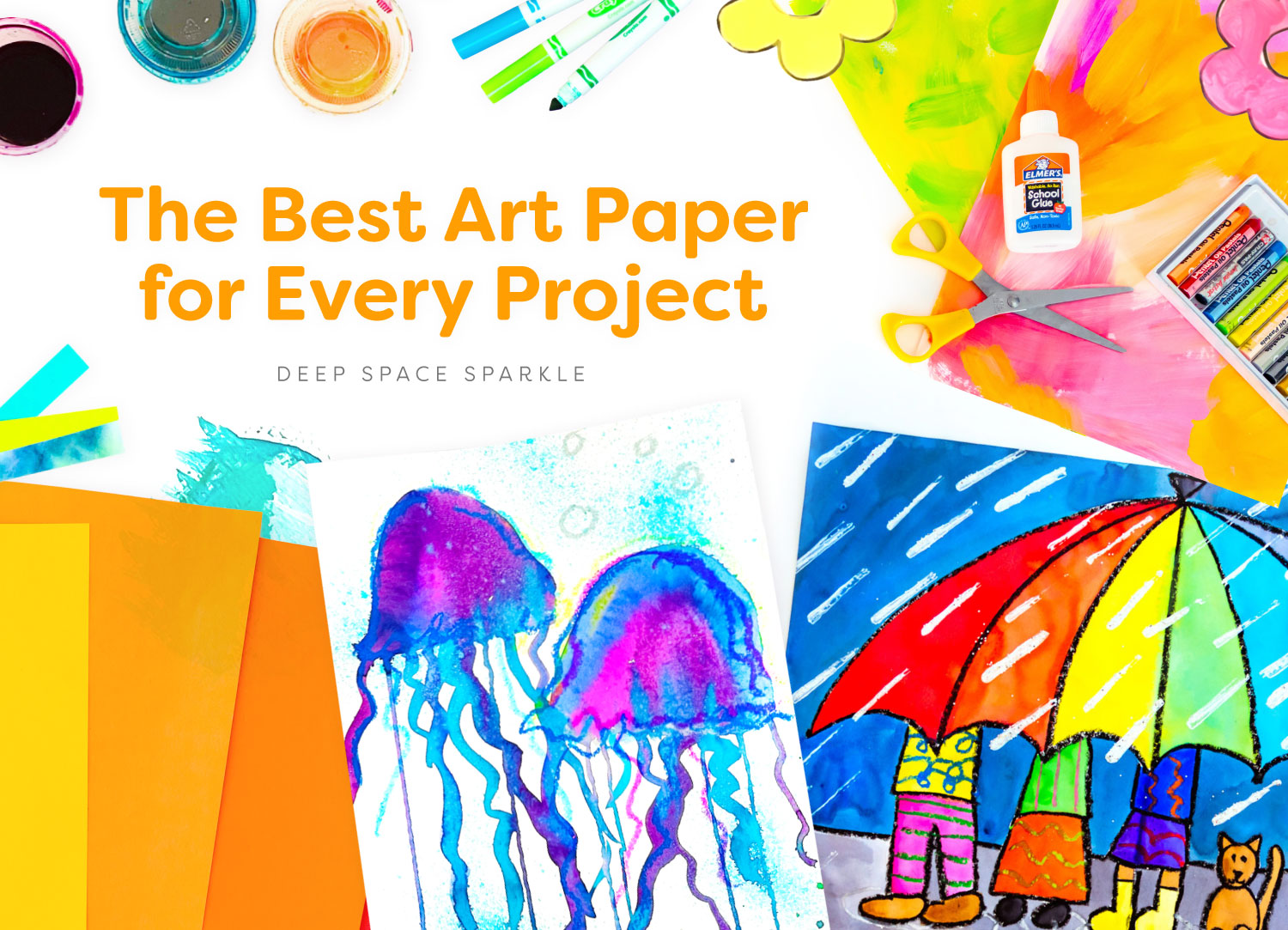When I first began teaching, I had no idea how to teach art to kids. Kid’s art projects and supplies were not on my radar. One of the most nagging questions I had was, what paper do I use?
This post is to help you discover what the best paper is best for tempera paint, watercolors, oil pastels and even markers.
This slide deck video will explain the types of paper I stock in my art room and how I use them:
There are SIX basic paper types used in my art room:
Sulphite drawing paper
School-grade watercolor paper
Scrapbook-style craft paper
Tissue paper
Canvas
Card stock
Sulphite Paper is also referred to as construction paper, but don’t be confused. It’s not the cheap construction paper found in craft stores.
Sulphite is a process that extracts the lignin from wood chips and produces pure cellulose fibers. This means that sulphite paper is a smooth, white and inexpensive drawing paper that is perfect in any art room or home-school environment.

I use sulphite paper in every art project that uses tempera paint, markers, oil pastel, collage, etc. The only time I don’t use sulphite paper is when I am teaching a watercolor blending lesson or using acrylic paints.
Watercolor Paper vs. Sulphite Paper | What Works Best?
Watercolor Paper

For all my watercolor art projects, I use school grade 90 lb watercolor paper. It’s inexpensive and comes in packs of 50 or 100. I use the cheapest school-grade product I can find and it works great. Just a little “tooth” can go along way in teaching kids the difference between regular paper and watercolor paper. Instead of soaking into construction paper, watercolor paper allows the paint to sit on top for a while and mingle with the other colors. I highly encourage you to purchase this paper for your classroom. It’s important to note that it is sometimes cheaper to buy large sheets (24″ x 36″) and cut them down to manageable pieces rather than books of pre-sized sheets.
Craft Paper
I use craft papers occasionally in the art room. I like to buy mine directly from craft stores like Michael’s as they offer great discounts and usually a better quality product than the craft or printed papers that you find in art supply catalogues.
Be on the lookout for 12” x 12” scrapbook quality paper packs that are in the sale bins. One big pack will last you years. To make the paper manageable, I cut down the papers into 6” x 6” squares and place in aluminum foil baking trays.
Card Stock–Yes the kind that comes from office supply stores–has become a favorite of mine. I don’t use cardstock for painting projects but I LOVE this paper for markers. If you ever want to do a drawing lessons and color with markers, card stock really helps make even inexpensive markers look great. The ink doesn’t sink or soak into the paper like it would with regular sulphite paper.
Painting in the art room is a must. Using the best paper really goes a long way in creating projects that look good and is easy on your budget. When using tempera paint, whether it is liquid or cake, I find that sulphite paper is good enough. It’s not expensive and it’s very durable. Watercolors, on the other hand, don’t perform as well on sulphite paper.
Watch this video to show you the difference between sulphite paper and watercolor paper as it applies to watercolor paint:
YOUR TURN…
What type of paper do you use?
More importantly, if you don’t live in the US and don’t have this type of paper, what do you use? Care to share your paper resources?
Download the Art Teacher’s Supply List for a free guide in helping you choose the best supplies for your classroom!















Your information and advice is always so helpful. I use the 90 pound Pacon drawing paper for drawing.. and tempera projects , and colored Pacon Tru-Ray 76 pound construction paper as well.
Do you prefer to use the white construction paper versus the white drawing paper? I wasn’t sure from your description if you were referring to the sulphite drawing paper or sulphite construction paper as the paper you frequently use.
I would like more information about your program and paper. I’m teaching art and art appreciation to two of our grandchildren, ages 7 and 9 (homeschooled). We’re having a wonderful time using different mediums and learning new techniques. I’ve been “winging it,” because I’m not an artist myself. I couldn’t seem to find a program that would help me teach both art appreciation and art, without spending unbelievable amounts of money. Thank you.
Sorry, I think I need to sign up for the newsletter.
Yes, the newsletter is a great way to stay up to date with my content. You might be very interested in my Teaching Art 101 self-guided course. It walks you through all aspects of teaching art to kids: supplies, dealing with little artists and lots of art projects and art technique tutorials. When you get a chance, check it out here: https://www.deepspacesparkle.com/teaching-art-101-information-page/
Otherwise, my site is full of art tips. Enjoy!
What weight of sulphite paper do you use for painting projects? Do you buy different weights for your class or just stock one? I’ve started teaching art at a little private school and am trying to stock the art supply from scratch – they pretty much have nothing. Trying not to overspend
Hi Jennifer,
I buy my sulphite paper from Blick. It’s called Tru-Ray by Pacon. It comes in one weight which I believe is around 76 lbs. I haven’t come across any that are heavier but I wouldn’t go much lighter. Won’t hold heavy tempera paint. Great question!
Hi Patty. I just checked Blick, and the 76 lb. Tru-Ray seems to be the colored paper. I can’t find white that is called Tru-Ray (except when included in packs of colored paper). The white is just called bright white sulphite and comes in three weights–50 lb., 60 lb., and 80 lb. Can you clarify which you use?
–Patricia
white try-ray paper 80 lb. you can buy individual packs for sure in 4 sizes (9 x 12, 12 x 18, 24 x 36, etc) Good luck!
I’m looking for good paper for Acrylic Painting that I can order in bulk or for a good price. Do you have any suggestions?::
Hi Just bought the sea Life Bundle and in the Fang and Nugget lesson it talks about cool and warm color painted sheets. I teach P/1 and wondering what are your guidelines for them creating these painted sheets, and does it matter which paper is used. I know we are using water color paper for the background.
I use regular sulphite paper. Here’s a post on painted paper that will help: https://www.deepspacesparkle.com/how-to-make-painted-paper/
Hi Thanks for the post. I am a senior and a beginner, well almost. Did not draw for almost 30 years. I have two questions please –
1. which paper/card stock can I use for pastels – that is reasonably cheap. I am looking for different neutral colors
2. Can I use construction paper from Dollarama/walmart for – pastesl/color pencils/water color pencils/charcoal pencils ?
Thank you in anticipation.
Do you have suggestions for brands that you like for watercolor paper? Thanks!
What paper do you use for acrylic paints?
Thank you
As a mentor of new art teachers, all of your information keeps me current. Thank you, Lisa